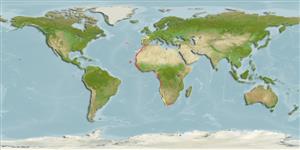>
Carangiformes (Jacks) >
Carangidae (Jacks and pompanos) > Naucratinae
Etymology: Seriola: Latin word diminutive with the meaning of a large earthenware pot (Ref. 45335).
Eponymy: William K Carpenter is a big game fisherman who is a friend of the author. [...] (Ref. 128868), visit book page.
Environment: milieu / climate zone / depth range / distribution range
Ecologia
marino benthopelagico; distribuzione batimetrica 0 - 200 m (Ref. 26999). Subtropical; 18°C - 27°C (Ref. 43448)
Eastern Atlantic: Bay of Biscay and Agadir, Morocco to Angola, including Cape Verde (Ref. 4233). Migrants were caught around Lampedusa Island (Mediterranean Sea) (Ref. 38310).
Size / Peso / Age
Maturity: Lm ? range ? - ? cm
Max length : 72.5 cm TL maschio/sesso non determinato; (Ref. 38310); common length : 40.0 cm TL maschio/sesso non determinato; (Ref. 26999)
Short description
Chiavi di identificazione | Morfologia | Morfometria
Spine dorsali (totale) : 8 - 9; Raggi dorsali molli (totale) : 28 - 33; Raggi anali molli: 17 - 21.
Adults are generally confined only in coastal waters over continental shelf, from the surface to at least 200 m. They feed on squids and fishes. Are confined to areas where surface temperature exceed 25°C, their distribution perhaps influenced by seasonal movements of the 18-27°C water mass along the African coast (Ref. 4233). Eggs are pelagic (Ref. 4233).
Life cycle and mating behavior
Maturità | Riproduzione | Deposizione | Uova | Fecundity | Larve
Smith-Vaniz, W.F., 1986. Carangidae. p. 815-844. In P.J.P. Whitehead, M.-L. Bauchot, J.-C. Hureau, J. Nielsen and E. Tortonese (eds.) Fishes of the north-eastern Atlantic and the Mediterranean. UNESCO, Paris. vol. 2. (Ref. 4233)
IUCN Red List Status (Ref. 130435: Version 2024-1)
Threat to humans
Reports of ciguatera poisoning (Ref. 30298)
Human uses
Pesca: commerciale; Pesce da pesca sportiva: si
Strumenti
Special reports
Download XML
Fonti Internet
Estimates based on models
Preferred temperature (Ref.
123201): 15.6 - 24.5, mean 18.7 °C (based on 118 cells).
Phylogenetic diversity index (Ref.
82804): PD
50 = 0.5020 [Uniqueness, from 0.5 = low to 2.0 = high].
Bayesian length-weight: a=0.01445 (0.00636 - 0.03286), b=2.93 (2.73 - 3.13), in cm total length, based on LWR estimates for this (Sub)family-body shape (Ref.
93245).
Trophic level (Ref.
69278): 4.6 ±0.59 se; based on food items.
Resilienza (Ref.
120179): Medio, tempo minimo di raddoppiamento della popolazione 1.4 - 4.4 anni (Preliminary K or Fecundity.).
Fishing Vulnerability (Ref.
59153): Moderate to high vulnerability (49 of 100).
Nutrients (Ref.
124155): Calcium = 49.3 [30.1, 103.4] mg/100g; Iron = 1.09 [0.61, 1.97] mg/100g; Protein = 18.2 [15.3, 21.1] %; Omega3 = 0.404 [0.247, 0.675] g/100g; Selenium = 35.6 [18.6, 68.4] μg/100g; VitaminA = 52.4 [7.0, 375.9] μg/100g; Zinc = 0.519 [0.365, 0.749] mg/100g (wet weight);
